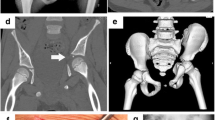Abstract
Purpose
External fixation has been widely implemented as a resuscitation strategy in combination with pelvic packing for high energy, hemodynamically unstable, pelvic ring injuries. The primary aim of this study is to compare urgent iliac crest (IC) versus supraacetabular (SA) external fixation in the setting of haemodynamic instability.
Methods
This is a retrospective review of a prospectively gathered registry at an urban level one trauma centre comparing placement of pelvic external fixator by SA or IC technique. Outcomes assessed were accuracy of pin placement, duration of procedure, and the effect on true pelvic circumference depending on type of fracture by Young and Burgess Classification system.
Results
Ninety-three haemodynamically unstable patients with a pelvic fracture included. Pin malpositioning was more common with IC than SA groups (proportional difference, − 40%; 95% CI, − 57 to − 20%; p < 0.0001). For APC injuries, there was a larger median reduction in pelvic circumference in the SA group than the IC group (median difference [MD], − 12.85 cm; 95% CI, − 27 to 0.1; p = 0.0485). In LC injuries, the SA group had an overall increase in pelvic circumference compared to an overall decrease in IC group (MD, 6.5 cm; 95% CI, 1.5 to 16.8; p = 0.0221). There was no difference in the operating room (OR) time (mean difference, − 5.4 min; 95% CI, − 32 to 22; p = 0.68).
Conclusions
In this clinical setting, we recommend placement of SA external fixator (versus IC) with similar operative times, fewer pin malpositions, and improved stabilization of pelvic circumference in APC and LC injuries.




Similar content being viewed by others
Availability of data and material
All data and materials comply with current standards.
Code availability
Not applicable.
References
Grotz MRW, Allami MK, Harwood P, Pape HC, Krettek C, Giannoudis PV (2005) Open pelvic fractures: epidemiology, current concepts of management and outcome. Injury 36(1):1–13. https://doi.org/10.1016/j.injury.2004.05.029
Costantini TW, Coimbra R, Holcomb JB et al (2016) Current management of hemorrhage from severe pelvic fractures: results of an American Association for the Surgery of Trauma multi-institutional trial. J Trauma Acute Care Surg 80(5):715–717. https://doi.org/10.1097/TA.0000000000001034
Chiara O, di Fratta E, Mariani A et al (2016) Efficacy of extra-peritoneal pelvic packing in hemodynamically unstable pelvic fractures, a propensity score analysis. World J Emerg Surg 11:22. https://doi.org/10.1186/s13017-016-0077-2
Jones AL, Powell JN, Kellam JF, McCormack RG, Dust W, Wimmer P (2017) Open pelvic fractures: a multicenter retrospective analysis. Orthop Clin North Am 28(3):345–350. https://doi.org/10.1016/S0030-5898(05)70293-5
JMP®, Version <JMP 14>. SAS Institute Inc., Cary, NC, (1989–2019)
Meinberg EG, Agel J, Roberts CS et al (2018) Fracture and dislocation classification compendium - 2018. J Orthop Trauma 32(Supplement 1):S1–S170
Pelvic Trauma: Initial evaluation and management - UpToDate. (2020) https://www.uptodate.com/contents/pelvic-trauma-initial-evaluation-and-management#H1. Accessed 19 Aug 2020
Pereira GJC, Damasceno ER, Dinhane DI, Bueno FM, Leite JBR, Ancheschi B da C. (2017) Epidemiology of pelvic ring fractures and injuries. Rev Bras Ortop 52(3):260–269. https://doi.org/10.1016/j.rboe.2017.05.012
Coccolini F, Stahel PF, Montori G et al (2017) Pelvic trauma: WSES classification and guidelines. World J Emerg Surg 12:5. https://doi.org/10.1186/s13017-017-0117-6
White CE, Hsu JR, Holcomb JB (2009) Haemodynamically unstable pelvic fractures. Injury 40(10):1023–1030. https://doi.org/10.1016/j.injury.2008.11.023
Gansslen A, Hildebrand F, Kretek C (2013) Supraacetabular external fixation for pain control in geriatric type B pelvic injuries. Acta Chir Orthop Traumatol Cechoslov 80(2):101–105
Parry JA, Smith WR, Moore EE, Burlew CCC, Mauffrey C. (2020) The past, present, and future management of hemodynamic instability in patients with unstable pelvic ring injuries. Injury. Published online February 2020. https://doi.org/10.1016/j.injury.2020.02.10. Accessed 19 Aug 2020
Stewart RG, Hammer N, Kieser DC (2019) External fixation of unstable pelvic fractures: a systematic review and meta-analysis. ANZ J Surg 89(9):1022–1027. https://doi.org/10.1111/ans.15027
Alipour F, Putti A, Moaveni A, Michael Fogarty ME. (2018) Comparative study of the morbidity of supra-acetabular pins versus iliac crest pins in pelvic external fixation. Orthop Proc. Vol 93-B. https://online.boneandjoint.org.uk/doi/abs/10.1302/0301-620X.93BSUPP_II.0930186 systematic review and meta-analysis. ANZ J Surg. 89(9). https://doi.org/10.1111/ans.15027. Accessed 21 Aug 2020
Grannis K, Tidwell J, Cho R (2018) Supra-acetabular pelvic external fixator, Percutaneous With Fluoroscopic Guidance. J Orthop Trauma 32(Suppl 1):S14–S15. https://doi.org/10.1097/BOT.0000000000001211
Author information
Authors and Affiliations
Contributions
All authors contributed to the study conception and design, material preparation, data collection, and analysis. All authors commented on previous versions of the manuscript. All authors read and approved the final manuscript.
Corresponding author
Ethics declarations
Ethics approval
This retrospective chart review study involving human participants was in accordance with the ethical standards of the institutional and national research committee and with the 1964 Helsinki Declaration and its later amendments or comparable ethical standards. The Human Investigation Committee (IRB) of Denver Health and University of Colorado, Denver Institutional Board Review approved this study.
Consent to participate
Not applicable.
Consent for publication
Not applicable.
Conflict of interest
Financial interests—Cyril Mauffrey has the following disclosures: Springer, publishing royalties and financial or material support, and Zimmer, research support. Joshua Parry has the following disclosures: Depuy Synthes, paid consultant. None of the other authors have financial interests to disclose.
Non-financial interests—Cyril Mauffrey has the following disclosures: Springer, editorial or governing board; DePuy, A Johnson & Johnson Company, Honorarium for educational courses; International Orthopaedics, editorial or governing board; and The European Journal of Orthopaedic Surgery and Traumatology, editorial or governing board. Joshua Parry has the following disclosure: The European Journal of Orthopaedic Surgery and Traumatology, editorial or governing board. Clay Burlew has the following disclosures: JTrauma, editorial or governing board, and TSACO, editorial or governing board. None of the other authors have non-financial interests to disclose.
Additional information
Publisher’s note
Springer Nature remains neutral with regard to jurisdictional claims in published maps and institutional affiliations.
Level of evidence: Level III
Rights and permissions
About this article
Cite this article
Chu, X., Strage, K.E., Hadeed, M. et al. Comparison of iliac crest versus supraacetabular external fixator in hemodynamically unstable patients with a pelvic ring injury. International Orthopaedics (SICOT) 45, 2121–2127 (2021). https://doi.org/10.1007/s00264-021-05005-5
Received:
Accepted:
Published:
Issue Date:
DOI: https://doi.org/10.1007/s00264-021-05005-5




